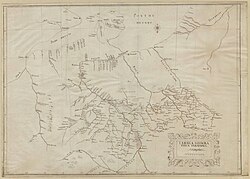Fryderyk Getkant
Fryderyk Getkant or Frederick Getkant (German: Friedrich Getkant, Latin: Fridericus Getkant, Lithuanian: Frydrichas (Bridžius) Gedkantas) (1600 – 1666) was a Prussian military engineer of Lithuanian descent,[1] artillery lieutenant and cartographer, (born in Ragnit or according to other sources in Rhineland, Holy Roman Empire). He is also known as a first who had written down Lithuanian folk song with melody in 1634.[2]

From the 1620s he worked in Pomeranian Voivodeship – Polish–Lithuanian Commonwealth, on the problems of defence, especially those related to King Władysław IV Vasa short-time maritime interests (Polish–Lithuanian Commonwealth Navy).[3]
He was one of the engineers working on fortifications in Großendorf (Władysławowo) and at Hela where Pomerania and Royal Prussia meet, (now Hel Peninsula) together with Johann Pleitner.

Under the threat of Russian military invasion Getkant organised reconstruction of Vilnius military objects. He also prepared city plans for Kaunas, Tauragė and Virbalis.
Author of many plans, maps and atlases (especially of the lands near the Baltic Sea), among them, manuscript atlas of 15 military maps of grand fortresses and fortifications – Topographia practica conscripta et recognita per Fridericum Getkant, mechanicum[4] (1638). Manuscript of his work covering mechanical and engineering aspects of his work was lost during the Lwów fire in 1662.
See also
[edit]External links
[edit]References
[edit]- ^ Rūta Janonienė; Tojana Račiūnaitė; Marius Iršėnas; Adomas Butrimas, eds. (2015). The Lithuanian Millennium: History, Art and Culture. Vilniaus dailės akademijos leidykla. p. 208. ISBN 9786094470974. Retrieved 1 April 2020.
- ^ Žičkienė, Aušra. "Dar kartą apie Bridžiaus Gedkanto įrašą XVII a. atminimų albume: kontekstų studija" (PDF) (in Lithuanian). Retrieved 1 April 2020.
- ^ Jadwiga Bzinkowska (1992). "The Most Valuable Cartographic Items from the Collection of the Jagiellonian Library and their Impact on Scientific Research". The LIBER Quarterly. 2. Archived from the original on 30 December 2005. Retrieved 24 November 2005.
- ^ "0414 Handritade kartverk; Band 28: Topographica practica (Getkant)" [Hand drawn map works: Band 28: Topographica practica (Getkant)] (in Swedish). Archived from the original on 9 June 2007.
